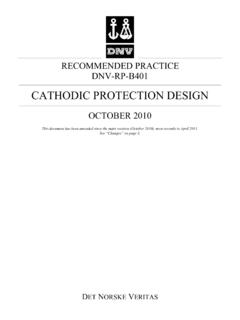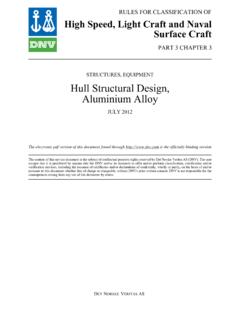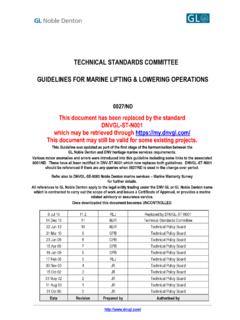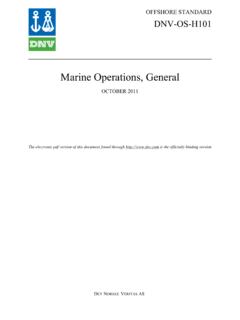Transcription of CARRIAGE OF DANGEROUS GOODS - Rules and standards
1 Rules FORCLASSIFICATION OFDET NORSKE VERITASV eritasveien 1, NO-1322 H vik, Norway Tel.: +47 67 57 99 00 Fax: +47 67 57 99 11 SHIPSNEWBUILDINGSSPECIAL SERVICE AND TYPEADDITIONAL CLASSPART 5 CHAPTER 11 CARRIAGE OF DANGEROUS GOODSJANUARY 2011 CONTENTSPAGESec. 1 General 4 Sec. 2 Requirements for CARRIAGE of DANGEROUS GOODS in Various Types of Cargo Spaces .. 8 CHANGES IN THE Rules The electronic pdf version of this document found through is the officially binding version Det Norske VeritasAny comments may be sent by e-mail to subscription orders or information about subscription terms, please use Typesetting (Adobe Frame Maker) by Det Norske VeritasIf any person suffers loss or damage which is proved to have been caused by any negligent act or omission of Det Norske Veritas, then Det Norske Veritas shall pay compensation tosuch person for his proved direct loss or damage.
2 However, the compensation shall not exceed an amount equal to ten times the fee charged for the service in question, provided thatthe maximum compensation shall never exceed USD 2 this provision "Det Norske Veritas" shall mean the Foundation Det Norske Veritas as well as all its subsidiaries, directors, officers, employees, agents and any other acting on behalfof Det Norske present edition of the Rules includes amendments and additions approved by the Executive Committee as of November2010 and supersedes the January 2010 edition of the same rule changes come into force as described chapter is valid until superseded by a revised changes coming into force 1 January 2011 Sec. 2 Requirements for CARRIAGE of DANGEROUS GOODS in various types of cargo spaces Item B1105 has been amended concerning temperature limits in oil tanks.
3 In Table C1, references to item B902 has been deleted in column Insulation of ER boundaries for Class ofdangerous GOODS . Table C3: References to applicable requirements for class of DANGEROUS GOODS ( to 9) have been added. Table D1: References to item B1104 and B1106 have been deleted in column Special requirements for Cargo type Ammonium nitrate based fertilizers, Type A . Reference to item B1102 has been added in column Special requirements for Cargo type Direct reduced Iron (B) and (C). Cargo type Wood pulp pellets has been deleted as it is no longer in and ClarificationsIn addition to the above stated rule requirements, a number of detected errors, corrections and clarifications have beenmade in the existing rule text. Rules for Ships, January 2011 Contents Page 3 DET NORSKE VERITASCONTENTSSec.
4 1 General Requirements .. 4A. 4A 100 Class notations and qualifiers .. 4A 4A 300 Assumption .. 4B. Documentation .. 4B 100 Documentation requirements .. 4C. Definitions .. 5C 100 Classes of DANGEROUS GOODS .. 5C 200 Terms .. 6 Sec. 2 Requirements for CARRIAGE of DANGEROUS GOODS in Various Types of Cargo Spaces .. 8A. General .. 8A 100 Application of requirements .. 8B. Requirements Applicable for Various Classes of DANGEROUS GOODS .. 8B 100 Fire water supply .. 8B 200 Fixed fire extinguishing .. 8B 300 Electrical installations .. 9B 400 Fire detection system and fire alarm 11B 500 Ventilation of cargo spaces .. 11B 600 Separate bilge pumping system and drainage arrangements for cargo spaces ..12B 700 Personnel protection and medical equipment .. 13B 800 Portable fire extinguishers .. 13B 900 Insulation of machinery space boundaries and separation of cargo spaces.
5 13B 1000 Self unloading systems for solid bulk 14B 1100 Special requirements .. 14C. Minimum Requirements for Cargo Spaces Intended for Packaged GOODS .. 15C 100 General .. 15D. Minimum Requirements for Cargo Spaces Intended for Solid Bulk Cargoes .. 24D 100 General .. 24 Rules for Ships, January 2011 Page 4 DET NORSKE VERITASSECTION 1 GENERAL REQUIREMENTSA. ClassificationA 100 Class notations and qualifiers101 Ships complying with requirements of this chapter may be given the class notation DG, appended by oneof the qualifiers B or P as described in Table 200 Scope201 The Rules in this section are considered to satisfy the requirements of SOLAS Reg. II-2/19 in respect ofcarriage of DANGEROUS GOODS in packaged For potentially hazardous bulk cargoes not subject to the SOLAS requirements mentioned in 201 therules are considered to meet the recommendation given in IMO's international maritime Solid Bulk CargoesCode - IMSBC Code with respect to ships construction and note:When authorised by the government of the flag state, the Society can issue a Document of Compliance, certifying thatthe construction and equipment are in compliance with SOLAS Reg.
6 II-2/19 and or with the IMSBC Code, such certification applicable parts of this chapter are used, also when class notations are not A 300 Assumption301 It is assumed that the operational requirements of SOLAS Chapter VII, Part A as well as those of theInternational maritime DANGEROUS GOODS Code, IMDG Code (IMO Resolution (IV)) or the InternationalMaritime Solid Bulk Cargoes Code , as applicable, are complied If DANGEROUS GOODS in packaged form, substances for well stimulation, carried on board a supplyvessel, are discharged, then other codes, resolutions, etc., shall be considered, Guidelines for the transportand handling of limited amounts of hazardous and noxious liquid substances in bulk on offshore support vessels(Resolution A673(16) as amended) .B. DocumentationB 100 Documentation requirements101 Documentation shall be submitted as required by Table B1, as applicable for the types of cargoesintended to be A1 Class notation and qualifiersClass notationDescriptionQualifierDescriptionD GShip intended for CARRIAGE of DANGEROUS goodsBIntended for CARRIAGE of DANGEROUS solid bulk for CARRIAGE of DANGEROUS GOODS in packaged B1 Documentation requirements for class notation DGObjectDocumentation typeAdditional descriptionFor approval (AP) or For information (FI)
7 Hazardous areasG080 Hazardous area classification drawingAPStructural fire protectionG060 Structural fire protection drawingBulkheads and decks separating cargo spaces from machinery spaces and water supply and distribution systemS010 Piping diagramAPS030 Capacity analysisAPZ030 System arrangement planAPFixed fire extinguishing system in cargo holdsG200 Fixed fire extinguishing system documentationAP Rules for Ships, January 2011 Page 5 DET NORSKE VERITAS102 For general requirements to documentation, see For a full definition of the documentation types, see DefinitionsC 100 Classes of DANGEROUS goods101 Classes of DANGEROUS GOODS according to SOLAS, Chapter VII, Part A, the IMSBC-Code and the IMDG-Code, are as follows:Class 1: ExplosivesVentilation systemV010 Ducting diagramCargo holds, cargo handling spaces and spaces having openings into those requirements for qualifier BInert gas systemS010 Piping diagramApplicable for cargoes requiring inerting of cargo hydrocarbon gas detection and alarm systemI200 Control and monitoring system documentationAPZ030 System arrangement planDetectors.
8 Call points and alarm oxygen indication systemI200 Control and monitoring system documentationAPFixed toxic gas detection and alarm systemI200 Control and monitoring system documentationAPCargoesZ100 SpecificationDangerous solid bulk cargoes intended to be carried in each cargo temperature monitoring systemI200 Control and monitoring system documentationAPAdditional requirements for qualifier PFire detection and alarm systemZ030 System arrangement planAPFixed fire extinguishing system in vehicle, special category and ro/ro spacesG200 Fixed fire extinguishing system documentationAPCargoesZ100 SpecificationDangerous GOODS in packaged form intended to be carried in each cargo :Substances and articles which have a mass explosion hazard Division :Substances and articles which have a projection hazard but not a mass explosion hazardDivision :Substances and articles which have a fire hazard and either a minor blast hazard or a minor projection hazard or both, but not a mass explosion hazardDivision :Substances and articles which present no significant hazard Guidance note:Substances and articles in this division are in compatibility group S if they are so packaged or designed that anyhazardous effects arising from the accidental functioning are confined within the package unless the package has beendegraded by fire, in which case all blast or projection effects are limited to the extent that they do not significantlyhinder fire-fighting or other emergency response efforts in the immediate vicinity of the Division.
9 Very insensitive substances which have a mass explosion hazardDivision :Extremely insensitive articles which do not have a mass explosion hazardTable B1 Documentation requirements for class notation DG (Continued)ObjectDocumentation typeAdditional descriptionFor approval (AP) or For information (FI) Rules for Ships, January 2011 Page 6 DET NORSKE VERITASC lass 2: GasesClass :Flammable gasesClass :Non-flammable, non-toxic gasesClass :Toxic gasesClass 3: Flammable liquidsClass 4: Flammable solids; substances liable to spontaneous combustion; substances which, in contactwith water, emit flammable gasesClass :Flammable solids, self-reactive substances and desensitized explosivesClass :Substances liable to spontaneous combustionClass :Substances which, in contact with water, emit flammable gasesClass 5: Oxidizing substances and organic peroxidesClass :Oxidizing substancesClass :Organic peroxidesClass 6: Toxic and infectious substancesClass :Toxic substancesClass :Infectious substancesClass 7: Radioactive materialClass 8: Corrosive substancesClass 9: Miscellaneous DANGEROUS substances and articlesClass MHB: Materials hazardous only in note:Class and Class 7 are neither covered by SOLAS Reg.
10 II-2/19 nor this Part 5, Chapter 11 of the Rules forClassification of C 200 Terms201 A-60 class divisions are smoke and fire resistant divisions formed by insulated steel bulkheads anddecks complying with the SOLAS standard fire test criteria for 60 minutes shall be insulated with non-combustible materials such that the average temperature of the unexposed sidewill not rise more than 140 C above the original temperature, nor will the temperature, at any one point,including any joint, rise more than 180 C above the original temperature, within 60 minutes.(SOLAS Reg. II-2 )202 Cargo spaces are all spaces used for cargo and trunks to such spaces.(SOLAS Reg. II-2 )203 Ro-ro cargo spaces are spaces not normally subdivided in any way and extending to either a substantiallength or the entire length of the ship in which GOODS (packaged or in bulk, in or on rail or road cars, vehicles,trailers, containers, pallets, demountable tanks or in or on similar stowage units or other receptacles)can beloaded and unloaded normally in a horizontal direction.



















